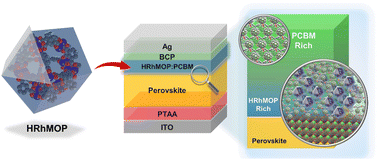A self-arranged metal–organic polyhedron/fullerene asymmetric structure improves the performance of inverted perovskite solar cells†
Abstract
Developing new chemistry to passivate the defects in the perovskite layer is highly desired in researching high-performance and stable perovskite solar cells (PVSCs). We herein explore supramolecular chemistry to passivate the perovskite film by entailing the employment of robust metal–organic polyhedra (MOPs), [Rh2(bdc)2]12 (HRhMOP; bdc = benzene-1,3-dicarboxylate). HRhMOP is found to establish well-defined packing voids to well accommodate the filling of [6,6]-phenyl-C61-butyric acid methyl ester (PCBM) that is often used as an electron transport layer (ETL) in PVSCs. Detailed analysis suggests that HRhMOP forms an asymmetric distribution in the PCBM ETL, and the self-arranged HRhMOP at the ETL/perovskite interface considerably suppresses the Pb0 formation and induces a larger band bending effect to facilitate interfacial charge transport. Synergetically combined effects give rise to a 9% enhancement in power conversion efficiency (PCE) of the derived inverted PVSCs. The successful utilization of MOPs could lead to the further development of supramolecular chemistry in state-of-the-art PVSCs.



 Please wait while we load your content...
Please wait while we load your content...